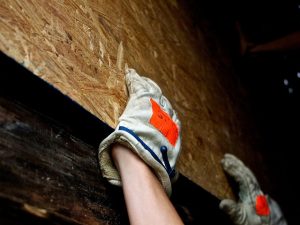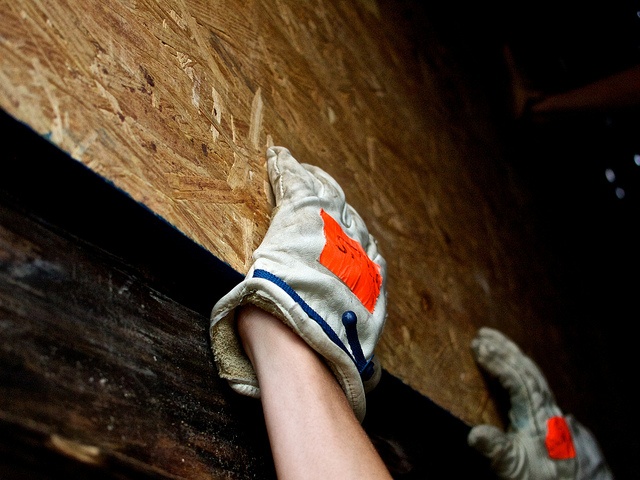Curious about house exterior wall construction? Want to build a small shed somewhere on your property, or try your hand at putting up a tiny house? Exterior walls aren’t terribly difficult to build, and the process takes a surprisingly short amount of time with the right tools and just a bit of know-how. This guide begins with framing exterior walls and continues with easy processes for sheathing and siding. Let’s get started!
A Quick Note on Permits
If you’re going to build exterior wall framing for an addition, shed, playhouse, or tiny house, it’s very important to check your local laws concerning building permits. The permit process is usually simple, and most areas have regulations posted online. In some areas, small projects can be completed without a permit. Take a moment to check requirements before you purchase materials or begin your project.
Exterior Wall Construction Layers
There are just a few layers in an exterior wall. The first layer consists of framing, usually made with 2×4 or 2×6 lumber. The second layer consists of sheathing, which is often made with OSB, plywood, or pressure-treated plywood depending on the project, its use, and the area you live in. The third layer is a protective barrier such as house wrap or tar paper, and the fourth layer is siding, which might be vinyl, metal, or a special exterior wood wall product such as T1-11 siding. Some siding comes pre-finished, and other types let you customize with the finish of your choice.

How to Build an Exterior Wall
The first step in house exterior wall construction applies to smaller projects as well. Whether you’re building a cool henhouse for your backyard chickens, erecting a garden shed, or setting up a fancy playhouse for your kids, you’ll want to start out with a level surface. A slab is ideal, particularly since you can easily put a subfloor in place.
1. Start by outlining your wall in chalk, directly on the slab or subfloor. Mark the location of any doors or windows.
2. Mark your top and bottom sill plates for studs. Wall studs are traditionally positioned 16” on center (OC). The first stud will be located at the end of the wall. Measure and mark a distance 15-1/4” from the end for the near edge of the next stud, and then measure and mark at 16-inch intervals for every stud that follows. Your second-to-last stud may be located closer to the last stud, but should not be any further than 15-1/4” away. This ensures that you’ll have ample space for mounting wall sheathing securely.
3. Using a chop saw or similar tool, cut your wall studs out of 2×4 or 2×6 lumber. Be sure to select your lumber with an eye for straight edges, as warped studs are not suitable for wall framing. Exact measurements will be determined by the size of your project. It’s a very good idea to test-fit your first stud to ensure that you’re satisfied with the overall height of your exterior wall.
4. Cut a corner post for each end of the wall. This is an “extra” stud that fits one 2×4-width away from the first and last stud. Every wall should have its own corner posts.
5. Use a nail gun with framing nails to assemble the wall. At this point, your frame will be lying on the slab or subfloor. Start with the end studs to ensure that your project is square, and then fill in with the rest of the studs. Nail through the top and bottom sill plates, straight into the ends of the stud pieces.
6. Use pieces of scrap 2×4 as spacers and fit your corner posts into place. Nail through the ends of the 2x4s that serve as your corner posts. Nail the 2×4 spacers into place for a bit of added stability.
7. Unless you’re planning to add sheathing before standing your walls up, get a helper to assist as you stand your wall up and set it in place. If you have a subfloor, you can now nail your wall frame into its final position. Attach the wall to the floor at each end and then fill in the middle. Have your helper keep a hand on the wall so it doesn’t tip while you’re working.
8. Repeat steps 1 through 7 for each wall, making appropriate modifications for windows and doors.
9. Insulate the corner post before you add sheathing. This way you won’t be stuck with an uninsulated corner later.
10. Now that framing exterior walls is complete, it’s time to move on to sheathing. The main advantage to sheathing exterior walls before raising them is that it’s far easier to do this while the project is lying flat than it is do keep your plywood or OSB panels level while nailing them into place with the walls already up. The downside is that the plywood or OSB adds a lot of weight to the walls, meaning you’re going to need more help to get them up and into place. Either way, be sure to measure carefully before you make any cuts.
11. Line up the plywood or OSB so the seams align with the middle of the studs. Use framing nails to secure the sheathing to the studs.
12. Raise the wall slowly if you haven’t already done so. Brace it into place and tack it down onto the subfloor. Raise the rest of the walls in the same way, bracing, checking for square, and checking for level. You’re going to want to work carefully and double-check all of your calculations here, as you want your walls to be flush and square.
13. Add corner bracing. This is temporary, and will keep your walls erect until you frame the roof. Nail corner brace 2x4s into place on each wall, double-checking for straightness as you go. You can anchor the braces by nailing them to stakes in the ground if needed.
14. Apply house wrap or a similar protective layer to the exterior of the OSB or plywood.
Now that you know how to build a exterior wall, you’re ready to purchase materials and start your project!




